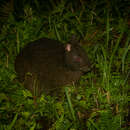Amami or Ryukyu rabbit (Pentalagus furnessi)
provided by EOL authors
The Amami or Rykyu rabbit, Amami or Amamino kuro usagi ("Amami plains black rabbit") is the most 'primitive' member of the family Leporidae and has evolved in isolation over the millennia in the absence of large active predators (11). Some of its characters resemble those in Miocene fossils from the Asian mainland (3). The lumbar vertebrae have broad transverse processes, the bullae and orbits are small. The rabbit has a long, bony palate, narrow anterior palatal foramina and the third lower premolar has symmetrical grooves
The rabbit occurs on the Japanese islands of Amami-Oshima and Tokuno-Shima in Kagoshima prefecture, in the Ryukyu or Nansei archipelago (4). It lived in dense primary forest, before widespread deforestation (1,4). The ideal habitat is in an area between mature and young forests. The rabbit uses dense mature forests as protection and to feed. It also uses the high density of perennial grasses and herbaceous ground cover in young forests to feed at different times of the year. The ideal habitat has easy access to young and mature forests.[5] The rabbit lives in dense, old growth forest, coastal cycad cover, mountain habitat with oak cover (4), broad leafed evergreen forests, secondary forests, forest edges and cutover areas where perennial grasses dominate (5). It does not occur in residential or cultivated areas. It occurs from sea level to 694 m on Amami and 645 m on Tokuna (4). It is estimated to have a distribution on Amami Island of 301.4 km² (4) and 33 km² on Tokuno (4,5). There are four populations, three being very small. (Yamada 2004). The range size on Amami Island fell by 20-40% from 1977-1994 (Yamada 2008).
The rabbit has a bulky body and relatively small eyes. It is @ 43-51cm long with a tail @ 15mm long and ears @ 45mm long. It weighs 2-3 kg. It has relatively short hind legs and feet and 1-2 cm long, thick, curved claws, used for digging and sometimes climbing. The very dense, woolly fur is dark brown on the back and reddish brown on the sides, fading to a lighter shade on the undersides.
It is nocturnal, spending the day in caves or simple dens dug into the soil in densely covered forest valleys (3,4).It makes calling noises, sounding like pikas.(4) It is mainly solitary and follows well-worn tracts through the undergrowth on its nightly foraging trips (3). It feeds on various plants and fruits, especially pampas grass in summer, acorns in winter and sprouts and young shoots of plants (4). Predators include humans, mongooses, introduced on Amami Island @ 1979 to control pit vipers (3,5,7), and feral cats and dogs (5,11).
The rabbit usually mates in November or December. Females dig tunnels @ 1 m long in the ground, where they give birth and where the young can hide during the day. Females give birth to one young, but may have two litters of 2-3 young a year (late March-May and September-December). The newborn young is blind and hairless, is 15 cm long (4). Every two nights, the mother opens the entrance to the hole, while watching for predators (such as venomous snakes), and then nurses her young, after which she closes the hole with soil and plant material by thumping on it with her front paws (3). Around 4 – 7 weeks later, the den is no longer sealed and the young rabbit accompanies its mother on her feeding trips (3), generally emerging from the burrows in April or May.
The Red List criteria rate the rabbit as Endangered, due to its small area of occupancy (335 km²) (4; 8) in 4 fragmented subpopulations (9) with 2 locations (Amami and Tokuno islands), experiencing a continuing decline in area of occupancy, area and quality of habitat and number of mature individuals (5;8). Decline is attributed to invasive predators (4) and habitat loss from forest clearing (5), forest road construction (5) and resort construction (10). People hunted the rabbit for medicinal value and food. There are @ 2,000-4,800 individuals on Amami island (8), a decline of @ 20% since the count of 2,500-6,100 in 1993 & 1994 (8); there are 120-300 on Tokuno Island. The rabbit was declared a natural monument of Japan in 1921, to prevent hunting and capture (3), and a special natural monument in 1963 to prevent hunting and trapping (5). These designations prohibited hunting and capture of the rabbits (4). The Center for Conservation of Amami Wildlife was established in 1999 and the rabbit was listed under the Japanese Endangered Species Act in 2004 (4). In 2005, the Ministry of the Environment sought to eradicate the introduced mongoose (4), but must also control feral cats and dogs (5,8) and preserve suitable habitat for the rabbit (3,5). Stopping forest road construction would discourage predators spreading into the rabbit’s range and restrict logging of mature forests for agriculture, golf courses, resorts and residential use, which destroys prime habitat for the rabbit and fragments local populations (5,6). Government subsidies to support the local economy have inhibited rabbit conservation, as they support forest road construction (12) and clearing for farmland (5). 90% of the mature forest area is privately or locally owned; 10% is owned by the national government (5). The Lagomorph Specialist Group of the International Union for the Conservation of Nature and Natural Resources proposed a conservation plan in 1990. The Amami Wildlife Conservation Center of the Ministry of the Environment, established in 1999, restarted a mongoose eradication program in 2005 and designated the Amami rabbit as endangered in 2004 for Japan.(4)

